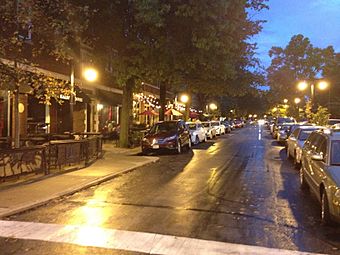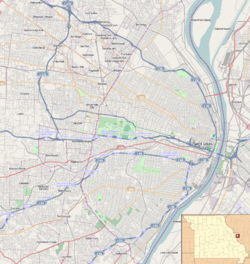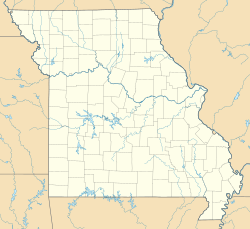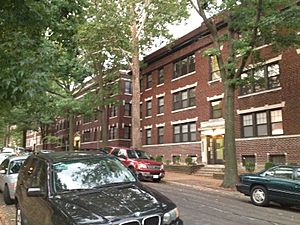DeMun, St. Louis facts for kids
|
Hi-Pointe–De Mun Historic District
|
|
 |
|
| Location | Roughly bounded by Clayton Road to the south, Big Bend Boulevard to the west, Northwood Avenue to the North, and Skinker Boulevard to the east. Clayton, Missouri |
|---|---|
| Area | 72.5 acres (29.3 ha) (original) 33 acres (13 ha) (increase) |
| Architect | Wright, Henry; et al. (original) Pitzman Company; Barnett, H.A. (increase) |
| Architectural style | Bungalow/Craftsman, Classical Revival, et al. (original) Mission/Spanish Revival, Bungalow/Craftsman, et al. (increase) |
| NRHP reference No. | 05000370 (original) 06001207 (increase) |
Quick facts for kids Significant dates |
|
| Added to NRHP | May 7, 2005 |
| Boundary increase | March 22, 2007 |
The Hi-Pointe–DeMun Historic District is a special neighborhood. It was added to the National Register of Historic Places in 2005. People often call this area simply "DeMun." It's unique because it sits right on the border between St. Louis, Missouri and Clayton, Missouri.
This district is generally found between Clayton Road (south), Big Bend Boulevard (west), Northwood Avenue (north), and Skinker Boulevard (east). It includes two main parts: DeMun Park and Hi-Pointe.
In 2005, there were 441 buildings in the district that were important to its history. These buildings covered about 72.5 acres. In 2007, the district grew to include another 33 acres with 111 more historic buildings.
DeMun is known as one of the most important historic neighborhoods in St. Louis. It is full of buildings from the 1920s and has peaceful, tree-lined streets. Many different people live here, including families, young professionals, and students. A lot of the students are from nearby Washington University in St. Louis.
DeMun is located in the center of the St. Louis area. It is also one of the best neighborhoods for walking. You can easily walk to many places.
Besides Washington University, DeMun is next to Forest Park. It is also close to movie theaters, grocery stores, and shops. You can also easily reach the fun attractions of the Delmar Loop in University City, Missouri. The downtown business area of Clayton, Missouri is also nearby. DeMun Avenue, in the middle of the neighborhood, has many restaurants, coffee shops, and stores. All of these are within walking distance.
Contents
History of DeMun
The DeMun neighborhood was built on land that once belonged to a French fur trader named Jules DeMun. His wife was Isabelle Gratiot DeMun. This large piece of land was given to the DeMun family by the King of Spain a long time ago.
Later, the land was divided. Part of it was sold to the city of St. Louis. Another part was sold in 1921 to the Lutheran Church-Missouri Synod to build Concordia Seminary. The rest of the land was sold and divided into smaller lots. This is how the neighborhood that now carries the DeMun name was created.
Designing the Neighborhood
The DeMun district was designed by a famous American landscape architect and city planner named Henry Wright. His plan for the area was finished in 1923. DeMun shows what became known as Wright’s "new town" idea.
This idea meant the neighborhood faced inward. It was designed to be away from the noise and traffic of big roads. There were only a few ways to enter from busy streets. The streets inside were curved to make cars drive slower and keep the area quiet.
The neighborhood had alleys for cars and service vehicles. It also had sidewalks for people to walk to shops, parks, and the school. Everything was located within this self-sufficient community. To use the land well, buildings were placed on smaller lots. People also shared central green spaces.
Because St. Louis has hills, taller buildings were placed at the bottom of the hill. Shorter ones were at the top. This made the area look nice and allowed everyone to get sunlight and fresh air. Wright also wanted many traditional building styles to be used. He suggested using only a few types of building materials. This made the buildings look both consistent and unique.
Buildings and Style
Both the DeMun Park and Hi-Pointe areas were designed as public neighborhoods. However, there were rules about how the land could be used. These rules helped make sure all the buildings looked similar. They also kept the area residential, meaning mostly homes. The rules also helped pay for taking care of the parks, trees, and streets.
Because of the careful planning, DeMun still looks very much like it did when it was built. Almost all of the main buildings in the district are part of the Hi-Pointe–DeMun Historic District.
Architectural Features
The neighborhood is mostly known for its brick and limestone buildings built after World War I. In the areas with many apartments, buildings of similar size used similar plans. They looked different by having unique tile roofs and brick patterns.
The single-family homes have a wider variety of styles. However, all the buildings in DeMun share a similar size, scale, and materials. This gives the neighborhood a feeling of being unified in its design.
Most buildings have stone foundations with dark brick walls. The bricks can be rough or smooth. They come in colors like green, tan, yellow, and brown. The colors are usually soft and muted. The mortar (the material between bricks) is often black, but can also be brown, red, light gray, or sand-colored.
Special touches on the buildings are made with limestone, terra cotta, and bricks of different colors and textures. Many original roofs were made of terra cotta tiles, either red or green. Slate was another common material for roofs. Many homes also have special leaded or art glass windows and doors. Even the garages matched the homes, using the same brick, mortar, and sometimes roof accents.
Fun Places Nearby
DeMun is close to Washington University, Concordia Seminary, and Fontbonne University. It is also near other St. Louis neighborhoods like Dogtown, the Delmar Loop, and Skinker–DeBaliviere.
Some fun places to visit nearby include:
- The Hi-Pointe Theater, built in 1922.
- Forest Park, a very large city park.
- The St. Louis Art Museum, where you can see amazing art.
- The St. Louis Zoo, home to many animals.
Images for kids






